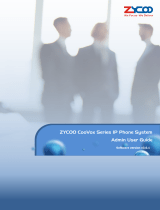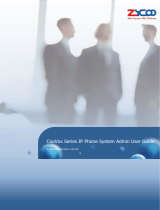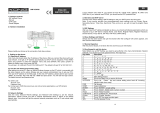Page is loading ...


1
Table of Content
Safety Instruction ................................................................................................................................ 4
1 Overview ................................................................................................................................... 5
2 Installation ................................................................................................................................ 6
2.1 Use PoE or external Power Adapter ........................................................................................... 6
2.2 Desktop and Wall-mount Installation ......................................................................................... 7
3 Introduction to the Phone User Interface .................................................................................... 9
3.1 Keypad ........................................................................................................................................ 9
3.2 Using Handset / Hands-free Speaker / Headphone ................................................................. 10
3.3 Screen User Interface ............................................................................................................... 11
3.4 Web Portal ................................................................................................................................ 12
4 Setting Up ................................................................................................................................ 13
4.1 Network Configuration ............................................................................................................. 13
4.2 Line Configurations ................................................................................................................... 14
5 Using the Phone ....................................................................................................................... 20
5.1 Making Phone Calls .................................................................................................................. 20
5.1.1 Make / Receive Second Call ...................................................................................................... 24
5.1.2 Merge / Split Two Calls (3-way Local Conference) ................................................................... 25
5.1.3 Call Transfer .............................................................................................................................. 25
5.2 Phonebook ................................................................................................................................ 26
5.2.1 Add / Edit / Delete Contact ...................................................................................................... 27
5.2.2 Add / Edit / Delete Group ......................................................................................................... 28
5.2.3 Browse and Add / Remove Contacts in Group ......................................................................... 28
5.3 Using Cloud Phonebook ........................................................................................................... 29
5.3.1 Open Cloud Phonebook ............................................................................................................ 30
5.4 Call Logs .................................................................................................................................... 30
5.5 Voice Message .......................................................................................................................... 32
5.6 Do-Not-Disturb ......................................................................................................................... 33
5.7 Auto-Answering ........................................................................................................................ 34
5.8 Call Forward .............................................................................................................................. 35
5.9 DSS LCD Configuration .............................................................................................................. 37
6 Phone Settings ......................................................................................................................... 39
6.1 Adjust Audio Volume ................................................................................................................ 39
6.2 Set Ring Tone Volume and Type ............................................................................................... 39
6.3 Adjust LCD Energy Saving ......................................................................................................... 39
6.4 Time/Date Settings ................................................................................................................... 40
6.5 Set Language ............................................................................................................................. 41
6.6 Reboot the Phone ..................................................................................................................... 41

2
6.7 Reset to Factory Default ........................................................................................................... 41
7 Web Portal .............................................................................................................................. 42
7.1 Web Portal Authentication ....................................................................................................... 42
7.2 Web Dial ................................................................................................................................... 42
7.3 SYSTEM / Information .............................................................................................................. 43
7.4 SYSTEM / Account .................................................................................................................... 43
7.5 SYSTEM / Configurations .......................................................................................................... 44
7.6 SYSTEM / Upgrade .................................................................................................................... 44
7.7 SYSTEM / Auto Provision .......................................................................................................... 44
7.8 SYSTEM / Tools ......................................................................................................................... 44
7.9 NETWORK / Basic ...................................................................................................................... 44
7.10 NETWORK / Advanced .............................................................................................................. 44
7.11 NETWORK / VPN ....................................................................................................................... 44
7.12 LINES / SIP ................................................................................................................................. 44
7.13 LINES / Dial Peer ....................................................................................................................... 48
7.14 LINES / Dial Plan ........................................................................................................................ 51
7.15 LINES / Basic Settings ................................................................................................................ 52
7.16 PHONE / Features ..................................................................................................................... 52
7.17 PHONE / Audio ......................................................................................................................... 54
7.18 PHONE / MCAST ....................................................................................................................... 56
7.19 PHONE / Time/Date .................................................................................................................. 56
7.20 PHONE / Advanced ................................................................................................................... 57
7.21 PHONEBOOK / Contacts ........................................................................................................... 57
7.22 PHONEBOOK / Cloud Phonebook ............................................................................................. 57
7.23 PHONEBOOK / Blacklist ............................................................................................................ 58
7.24 PHONEBOOK / Advanced.......................................................................................................... 58
7.25 CALL LOGS ................................................................................................................................. 58
7.26 FUNCTION KEY / Function Key .................................................................................................. 59
7.27 FUNCTION KEY / Softkey........................................................................................................... 60
8 Advanced Features .................................................................................................................. 61
8.1 VPN ........................................................................................................................................... 61
8.2 L2TP .......................................................................................................................................... 61
8.3 OpenVPN .................................................................................................................................. 62
9 Trouble Shooting ..................................................................................................................... 63
9.1 Get Phone System Information ................................................................................................ 63
9.2 Upgrade to the latest software ................................................................................................ 63
9.3 Reboot Phone ........................................................................................................................... 63
9.4 Reset Phone to Factory Default ................................................................................................ 63
9.5 Network Packets Capture ......................................................................................................... 64
9.6 Entering Post Mode and Recover System Image ...................................................................... 64
9.7 Common Trouble Cases ............................................................................................................ 65

3
Appendix I - Icon Illustration .............................................................................................................. 66
Appendix II – Text Input from Keypad ................................................................................................ 67
Appendix III – LED Definition .............................................................................................................. 69

4
Safety Instruction
Please read the following safety notices before installing or using this product. They are crucial for the safe and reliable
operation of the product.
Please use the external power supply that is included in the package. Other power supply may cause damage to
the phone, affect the behavior or induce noise.
Before using the external power supply in the package, please check the AC power voltage. Inaccurate power
voltage may cause electric shock or burn the power adaptor.
Please do not damage the power cord. If power cord or plug is impaired, do not use it, it may cause fire or
electric shock.
Do not drop, knock or shake the phone. Rough handling can break internal circuit boards.
This phone is designed for indoor use only. Do not install the phone in places where there is direct sunlight. Also
do not put the phone on carpets or cushions in case of overheat or fire.
Avoid exposure the phone to high temperature or below 0℃ or high humidity.
Avoid wetting the phone with any liquid.
Do not attempt to open it. Non-expert handling of the phone could damage it. Consult your authorized dealer for
help, or else it may cause fire, electric shock.
Do not use harsh chemicals, cleaning solvents, or strong detergents to clean it. Wipe it with a soft cloth that has
been slightly dampened in a mild soap and water solution.
When lightning, do not touch power plug, it may cause an electric shock.
Do not install this phone in an ill-ventilated place. You are in a situation that could cause bodily injury. Before you
work on any equipment, be aware of the hazards involved with electrical circuitry and be familiar with standard
practices for preventing accidents.

5
1 Overview
The new H83 color screen IP Phone is a high-end enterprise desktop phone which comes with intelligent LCD the DSS
Key-mapping to increase enterprise users’ productivity at a cost-effective price.
The DSS key-mapping is designed with intelligence to support dynamic usage to substitute expansion modules. There
are 7 DSS keys corresponded to the color LCD display to provide dynamic Line/DSS/BLF functions up to four pages at
virtualized total 28 DSS keys. User may configure/customize each DSS key in each page. Every DSS key has a LED
indication in green, red, and yellow colors to reflect the key state. A page shortcut button is also designed to allow
user to quickly switch between pages. H83 is the most economic choice for SMB office and enterprise supervisors.
H83 inherits all features from enterprise phones, such as HD voice in handset, headset, and full-duplex speakerphone
modes, PoE, Fast/Gigabit Ethernet, QoS, secure transmission, auto-provisioning, and more.
H83 is a great office productivity appliance for enterprise users. The old DSS key label is inconvenient and not
environmental friendly. H83’s intelligent LCD the DSS Key-mapping provides users the flexibility to change DSS key
definition and display through easy configuration. Meanwhile, with its intelligent design of the DSS key, it can be
multiplied as expansion modules to save space and cost. H83 will provide the best user experience to advance
enterprise users.”
In order to help some users who are interested to read every detail of the product, this user manual is provided as a
user’s reference guide. Still, the document might not be up to date with the newly release software, so please kindly
download updated the latest user manual from website, or contact with support if you have any question using H83.

6
2 Installation
2.1 Use PoE or external Power Adapter
H83 color screen IP phone, called as ‘H83’ hereafter, supports two power supply modes, power supply from
external power adapter and H83 also supports 802.3af Class 1 Power over Ethernet (PoE) complied switch.
PoE power supply saves the space and cost of providing the phone additional power outlet. With a PoE
switch, the phone can be powered through a single Ethernet cable which is also used for data transmission.
By attaching UPS system to PoE switch, the phone can keep working at power outage just like traditional
PSTN telephone which is powered by the telephone line.
For users who do not have PoE equipment, the traditional power adapter should be used. If the phone is
connected to a PoE switch and power adapter at the same time, the power adapter will be used in priority and
will switch to PoE power supply at power failure on the power adapter.
Please use the power adapter supplied and the PoE switch met the specifications to ensure the phone work
properly.

7
2.2 Desktop and Wall-mount Installation
H83 supports two installation mode, desktop and wall-mount. To set up the phone to be used on desktop,
please follow the instructions in below picture to install the phone.
Desktop Installation
To mount the phone on the wall, please follow the instructions in below picture.
Wall-mount Installation
Please connect power adapter, network, PC, handset, and headphone to the corresponding ports as
described in below picture.

8
Connecting Peripherals and Network

9
3 Introduction to the Phone User Interface
3.1 Keypad
Keypad
The above picture shows the keypad layout of H83. Each key provides its own specific function. User should
refer to the illustration in this section about the usage of each key and the description in this document about
each function.
Some keys support long-press function. User can press and hold the key for 1.5 seconds to trigger the
long-press function.
DSS keys - You could customize these DSS keys with some preset functions.
LCD page switch key - You could switch the LCD pages by pressing this key.
Soft Keys – These four buttons provide different functions corresponding to the soft-menu displayed on
the screen.
Power key - The key will green flash when the phone reboot with power supply.
Headset key - When you pressed the key, you could make a call using the headset.
MWI key - You could view the voice messages by pressing this key.
Mute key - Mute you phone. you can also mute the microphone with this button during talking mode.

10
Navigation Keys – User can press up/down navigation keys to change line focus in talking screen or
move cursor in a screen with list items; in some configuration or text editor screen, user can press
left/right navigation keys to switch option or move cursor to the left / right.
Numeric Keys – The 12 standard telephone keys provide the same function as standard telephones, but
further to the standard function, some keys also provide special function by long-pressing the keys.
Key # - Long-press to lock the phone. (Default PIN is 123)
Key Page - Long-press to open LCD page configuration.
Hold key - you could hold a call by pressing this key.
Transfer key - You could transfer a call by pressing this key.
Conference key - You could invite a third part to join your call by pressing this key.
Redial – By pressing ‘Redial’ button, user can redial the last dialed number.
Volume -/+key – In standby, ringing, ring configuration screen, user can press 2 buttons to lower/increase
the ringtone volume, in talking and audio volume adjustment screen, user can press this button to
lower/increase the audio volume.
Speaker – By pressing this button once, user can turn on the audio channel of hands-free speaker
3.2 Using Handset / Hands-free Speaker / Headphone
Using Handset
To talk over handset, user should lift the handset off the phone and dial the number, or dial the number first,
then lift the handset and the number will be dialed. User can switch audio channel to handset by lifting the
handset when audio channel is opened in speaker or headphone.
Using Hands-free Speaker
To talk over hands-free speaker, user should press the hands-free button then dial the number, or dial the
number first then press the hands-free button. User can switch audio channel to the speaker from handset by
pressing the hands-free button when audio channel is opened in handset.
Using Headphone
To use headphone, by default, user should headset button which is defined by DSS key to turn on the
headphone. Same as handset and hands-free speaker, user can dial the number before or after headphone
turned on.
Using Line Keys(Defined by DSS Key)
User can use line key to make or answer a call on specific line. If handset has been lifted, the audio channel
will be opened in handset, otherwise, the audio channel will be opened in hands-free speaker or headphone.

11
3.3 Screen User Interface
Screen Layout / Default Standby Screen
The screen user interface is mostly presented in the above layout except some prompt messages. The upper
area is the main screen to display the phone status and information or data for viewing or editing. The lower
area is the software menu (soft-menu) buttons which will change against user’s action or phone status.
The above picture shows the default standby screen which is also the root of the soft-menu. The default
standby screen shows the greeting words and effective feature indications like voice message, missed call,
auto-answering, do-not-disturb, call forward, lock state, and the network connectivity. User can get back to
the default standby screen mostly by lifting and putting by the handset.
The icon illustration is described in Appendix I - Icon Illustration.
In some screens, there are more items or long text to be displayed which could not fit into the screen. They
will be arranged in a list or multiple lines with a scroll bar. If user sees a scroll bar, user can use up/down
navigation buttons to scroll the list. By long-pressed the navigation keys, user can scroll the list or items in a
faster speed.
Vertical Scroll Bar

12
3.4 Web Portal
User can also use the phone’s web portal to manage or operate the phone. User should open the phone’s
web portal page by entering the IP address in the Web browser. To get the phone’s IP address, user could
press the soft-menu button [Menu] -> [Status] or by pressing [Down] navigation key.
Check the phone’s IP Address
The first screen of the phone’s web portal is the login page.
Web Portal Login Page
User must enter the username and password to log in to the web portal. The default username and
password are both ‘admin’. For the detail of web portal operations, please refer to 7 Web Portal.

13
4 Setting Up
In order to get the phone ready for making and receiving phone calls, the phone must be configured with
correct network configurations and at least one of the lines must be configured with an SIP telephony service.
4.1 Network Configuration
The phone relies on IP network connection to provide service. Unlike traditional phone system based on a
circuit switched wire technology, IP phones are connected to each other over the network and exchange data
in packet basis based on the phones’ IP address.
To enable the phone, the network parameters must be configured properly first. To configure network
parameters, user should open the network configuration screen through soft-menu [Menu] -> [Settings] ->
[Advanced Settings] -> [Network] -> [Network Settings] from standby screen.
NOTICE!
If user saw a ‘Network Disconnected’ icon flashing in the middle of screen, it means the network
cable was not correctly connected to the phone’s network port. Please check if the cable is properly
connected to the phone and to the network switch, router, or modem.
There are three common IP configuration modes.
Dynamic Host Configuration Protocol (DHCP) – This is the automatic configuration mode by getting
network configurations from a DHCP server. Users don’t have to configure any parameters manually. All
configuration parameters will be getting from DHCP server and applied to the phone. This is
recommended for most users.
Static IP Configuration – This option allows user to configure each IP parameters manually, including IP
Address, Subnet Mask, Default Gateway, and DNS servers. This is usually used by advanced users.
PPPoE – This option is often used by users who connect the phone directly to a broadband modem or
router. To establish a PPPoE connection, user should configure username and password provided by
the service provider.
The phone is default configured in DHCP mode.

14
4.2 Line Configurations
A SIP line (SIP account) must be configured properly to be able to provide telephony service. The line
configuration is like a virtualized SIM card. Just like a SIM card on a mobile phone, it stores the service
provider and the account information used for registration and authentication. When the phone is applied with
the configuration, it will register the phone to the service provider with the server’s address and user’s
authentication as stored in the configurations.
To configure a line manually, user may open the line configuration screen through soft-menu button [Menu] ->
[Settings] -> [Advanced Settings] -> [Accounts] -> [SIP1] / [SIP2] / [SIP3] / [SIP4] -> [Basic Settings] from the
standby screen.
NOTICE!
User must enter correct PIN code to be able to enter advanced settings to edit line configuration. (The
default PIN is 123)
The parameters and screens are listed in below pictures.
Configure SIP Server (Proxy) Address
Configure SIP Server (Proxy) Port

15
Configure SIP Username
Configure Authentication Name
Configure SIP Authentication Password

16
Configure Display Name
Enable / Disable Outbound Proxy
Enable / Disable Sip Line
Save the configurations by pressing [OK] or [Save] button when done.
For users who want to configure more options, user should use web management portal to modify or
Advanced Settings in accounts on the individual line to configure those options.

17
Configure Advanced Line Options
Configure SIP Realm/Domain
Configure Unregistered Dial
Enable / Disable Anonymous
Configure DTMF Mode

18
Enable / Disable STUN
Configure Local Port
Configure Ring Type
Configure MWI Number
Configure Pickup Number
Configure Park Number

19
Configure Join Call Number
Enable / Disable Missed Call
Enable / Disable Feature Sync
Enable / Disable SCA
NOTICE!
On the phone screen, user can only configure whether STUN / Outbound Proxy is enabled, to change
the STUN / Outbound Proxy server address, user must edit in the phone web portal. (Please refer to
7.12 LINES/SIP and 7.15 LINES/Basic Settings)
/










